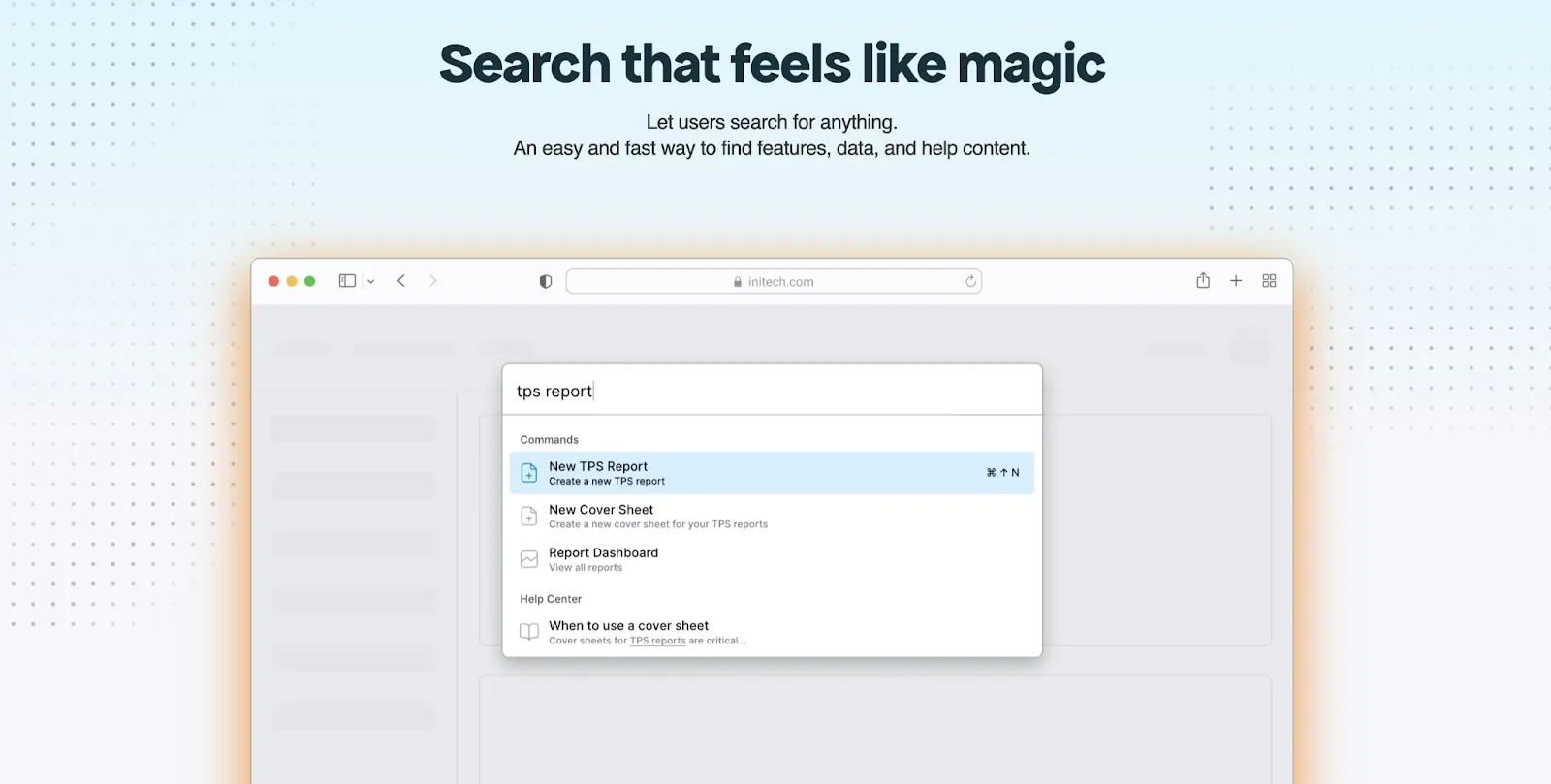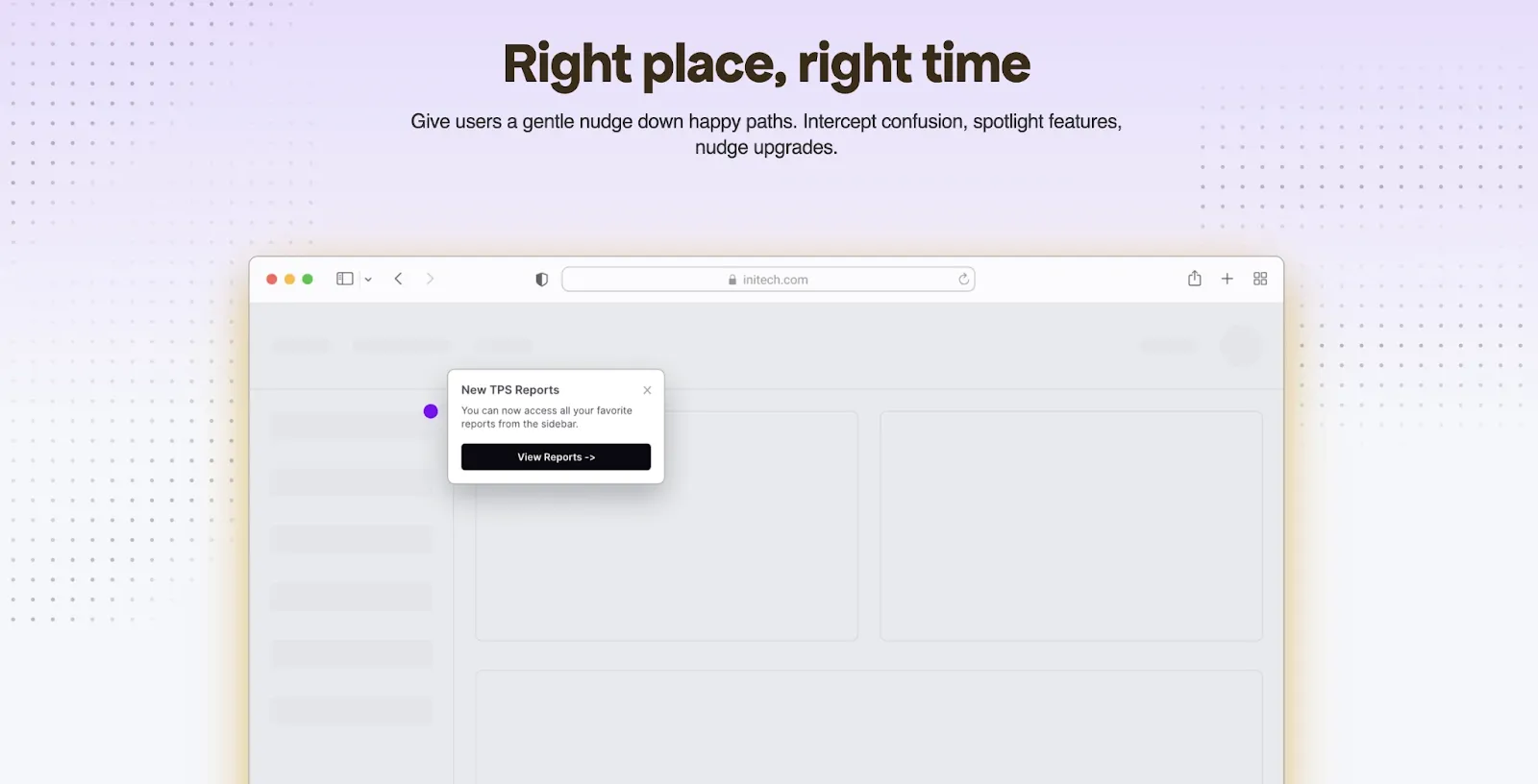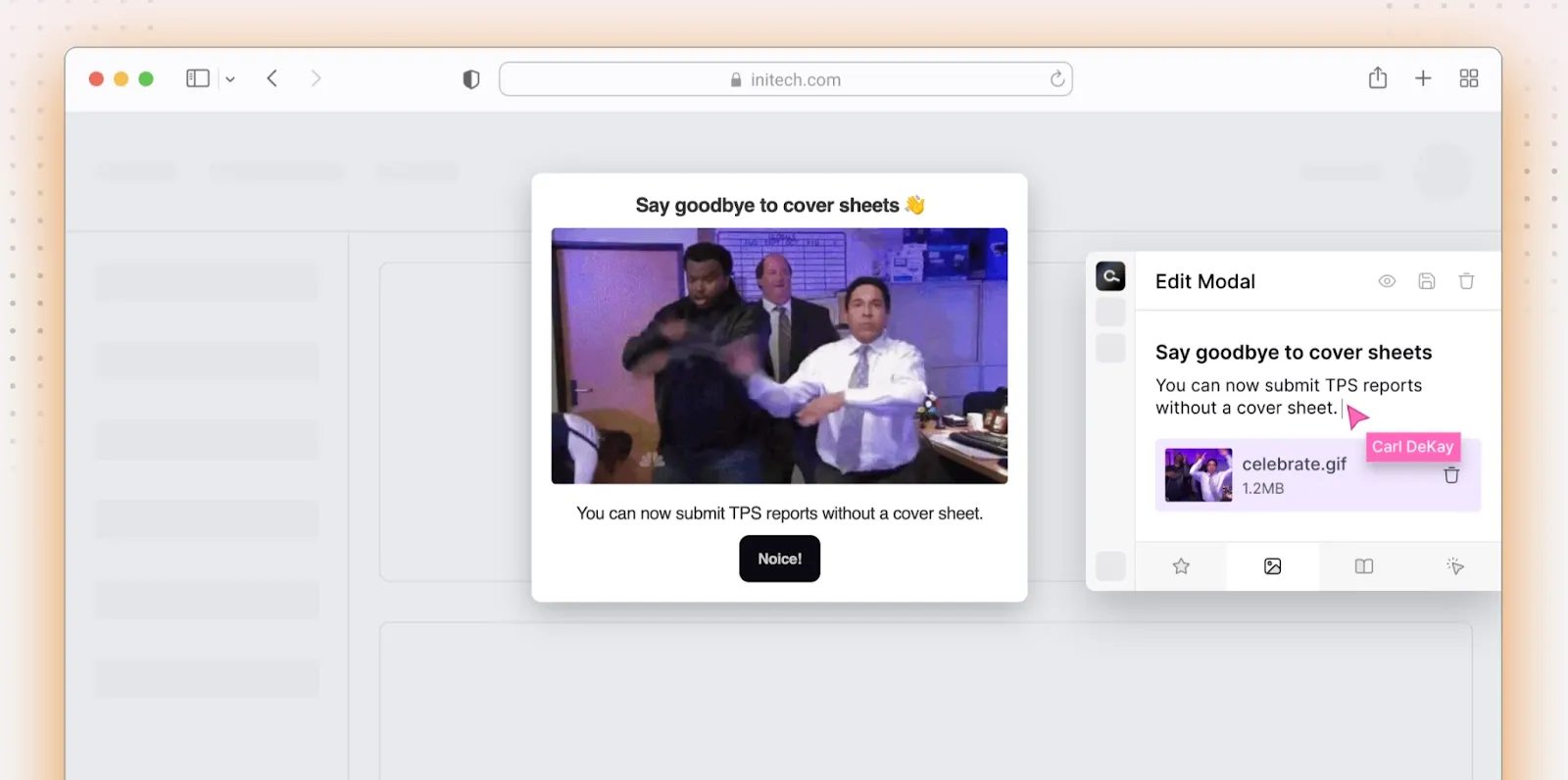7 feature discovery hacks to supercharge product adoption
It's not enough to ship new features; you need to make them discoverable too. Here's everything you reasonably need to know about feature discovery.

Have you ever bought a pair of shoes and then only ever worn one of them while the other one gathered dust in your dresser? Probably not. Neither has just about anyone else.
Yet that's what most users are doing with your product. If you've studied the data, you've probably seen that most users never use most features. They find a few useful things and then neglect the rest.
That's not only sad for them (they get less value for the same price), but also threatens your bottom line: If customers only use a few features and don't realize all the value they could, they're more likely to churn.
That's why effective feature discovery is so important!
Now, I’ve made those numbers up, but you don't need a team of data scientists to know this is roughly true. In fact, pick some really cool advanced feature that your product does that you know is a little hidden.
When you’re building SaaS, especially with product led growth, you need to build new features, ship new features, and then signpost those features. If you neglect to implement feature discovery, you fail the loyal users you’ve sworn to delight.
Key Takeaways
- Highlighting the Problem: Many advanced features in SaaS products remain unknown to a significant portion of users and even to some team members.
- Feature Discovery Defined: The process of making users aware of and competent in using both new and existing features of a product. It's essential due to the busy and diverse nature of users, who may not discover these features on their own.
- AI-Powered In-App Search: Utilize an AI-driven search tool within the app, like Command AI's Spotlight, to help users find and understand features relevant to their needs, enhancing the user experience and encouraging feature discovery.
- Interactive Tooltips and Checklists: Implement spotlight buttons with tooltips to draw attention to new features, and use case-driven checklists to guide users through utilizing different features, improving engagement and feature adoption.
- In-App Messages and Email Communications: Trigger in-app messages based on user actions to promote relevant features, and use targeted email communication to educate users about feature-related content, encouraging deeper product engagement.
- Rewards and Marketable Product Launches: Incentivize users to engage with new features through rewards for participating in product tours, and make product launches exciting events to generate user interest and educate them about the new features.
- Command AI Integration: Leverage tools like Command AI for seamless integration of these feature discovery strategies, enhancing user experience without being overbearing, and providing actionable insights for continuous UX improvement.
What is feature discovery and why can’t users just figure it out?
Feature discovery is the process by which users learn about new or existing capabilities within a product.
It's about making sure that users are aware of, understand, and know how to use the features that you’ve spent time and resources to develop. It's not only about introducing new features to users but also about reminding them of features they may have forgotten, as well as feature updates.
But why do we need feature discovery at all - why can’t users just figure it out? Well, for one, your users are busy. Research shows that they will be using your product alongside around 9 others each day. Asking them to explore and experiment with your product to discover all its features themselves is unrealistic, especially when they have tasks to complete and deadlines to meet.
Also, not all users are the same as the product adoption curve shows. While some might enjoy the thrill of discovery, others find it frustrating and confusing. So it’s essential to assist users in their user journey, making feature discovery an integral part of your user experience.
When you see how easy it is to deploy feature discovery techniques and the outsized impact they can produce, you’ll kick yourself for not having employed them earlier. As a sample, here’s a 2-minute video where we walk you through setting up some in-app guidance to improve feature discovery using Command AI so you can see how hilariously simple this all is:
7 feature discovery tips and tricks to build your product adoption strategy around
Now, let's dive into the seven feature discovery hacks that can superpower your product adoption:
#1: An AI-powered in-app search to solve their use case

An AI-powered in-app search function can be a powerful tool for feature discovery. At Command AI, this is our industry-leading Spotlight.
It can assist users in finding the right feature at the right time and reveal user behavior, allowing you to analyze patterns, predict what they might need next, and offer suggestions or shortcuts to both relevant new features and existing features, too.
This not only enables you to identify features that users care about. But, you can also educate users about the capabilities of your product and provide a personalized experience that makes them feel valued and understood.
Having a user-delighting search bar in your product is basically you letting the user be proactive rather than reactive. In turn, this means you understand your users’ intent within the product. This could be what they ultimately want to achieve - information about their goals - or it could be about things they are struggling with; their pain points.
This gives you much more contextual information with which you can improve the experience for new users as well as encourage feature discovery for the right users, too.
The way Command AI’s site search function works means you can preprogram it to surface different things in different ways at different times to the user. This includes data, actions, as well as relevant features. So you’re fulfilling the promise of a search while guiding the user where you want them to go and what you want them to see.
For example, they might search for a use case. Your search will return the core features for that use case but also display a few new features, which you know make sense for that use case and user personas, and are unlikely to discover themselves. It allows you to aid the discovery as they explore.
#2: Spotlight buttons with product tool-tips

Product tooltips, often highlighted or marked with an icon indicating something new, can draw users' attention to specific features. When the user hovers over the tooltip, it provides a brief description or hint that can further facilitate feature discovery.
The tooltip can explain what the feature does and how it can help them, providing a quick, on-demand learning experience that you have determined and triggered based on prior user engagement.
Product tooltips can be used to easily implement feature discovery, they're simple, and everyone understands it. It’s an effective way to draw the eye of the user and educate them in real time. They’ve seen this done before, and they’re happy to play along. It’s a non-intrusive way to increase their knowledge.
A simple tooltip built in Command AI
The best thing about using tooltips for feature discovery is how quick they are to set up and create. In Command AI, you can configure these rapidly without code. So there’s no excuse for not delivering useful and timely tooltips to your users. For details on deploying tooltips without annoying your users - check out our guide to product tooltips best practices.
#3: Walk your user through a use case-driven checklist

Use case-driven checklists can be a powerful way to boost user engagement and guide users through the feature discovery process.
By breaking down complex tasks into manageable steps and linking each step to a specific feature, you can effectively teach users how to use your product to accomplish their goals. This approach can also help users understand the value of each feature and drive feature adoption as they can see firsthand how it contributes to their goals.

I am a huge advocate for checklists. In my long read on user onboarding, I go into the science of checklists and outline why they are even more useful for user onboarding than they are for anything else
“For an activity you do every day, your neural pathways are pretty established, and it’s super efficient to process along these routes.
But for new things, your brain is hyper-inefficient. It will immediately forget things, get confused, and even make simple errors. And your users are brand new... this is why a user onboarding checklist is my personal favorite onboarding tool. You can see what you have to do, what you’ve already done, and what you are yet to do - and you don’t have to try to remember any of it. You’re simply guided along so your brainpower can focus on learning the challenges in front of it.”
If you want to learn some rules about how to create checklists for user onboarding then I recommend this article from our CEO on creating user onboarding checklists that don't suck.
What you want to do with your checklist is:
- Keep the scope tight
- Provide clear action-oriented steps
- Make it a completeable length
- Trigger it from a previous user action
- Have the checklist align with a use case
- Personalize your checklist to your user’s persona
The last one there is a little advanced, but in Command AI, you’ll find many advanced things you can do once you get the ball rolling. It’s so quick to set up that it affords you the time and space to add these optimizations, which can really take your onboarding to the next level.
#4: Send an in-app message triggered by an event
In-app messages triggered by specific events can be an effective way to promote feature discovery.
For instance, when a user completes a task or achieves a milestone, you can send a message introducing them to a feature that could help them with the next step. This approach ensures that users learn about new features when they are most relevant and useful, increasing the likelihood of adoption.
The chatbot UX is a familiar one, and users tend to like familiarity.
We have a really good read here from Lucas that goes in-depth into this and compares multiple form factors: Using In-App Messaging to Improve User Onboarding.
The article concludes that, yes, we should use in-app messaging, but we should make sure to contextualize it and continue to optimize and improve it. But what does Lucas mean by “contextualizing” here? He gives some examples:
- Location: where the user is in your product
- History: what actions a user has taken so far
- Unexplored territory: key functionality that the user has not yet tried
- Current focus: what the user has recently been working on in your product
- Use case: the user's main goal
You probably won’t be able to incorporate all of these elements when you ship a chat setting. If you do, you can sleep soundly knowing that your in-app messaging UX is phenomenal.
If you are a normal person, then you can, at minimum, try to lean on two or three of these items to inform how you construct these prompts, their timing, and content.
#5: Reward users for opting into a product tour
We all know what a product tour is. Sometimes we enjoy them, and sometimes we don’t. Some companies seem to create product tours that go on forever or pop-up at the most annoying times 👿.
Thankfully, in Command AI, product tours are the outcome of showing multiple nudges in sequence. This is useful for introducing your users to a new feature of your product or walking users through a multi-step flow within your app. We give you the tools to control their length and what triggers them.
Now, it is in your interest for your product tour to be sufficiently long, but you don’t want it to drag, or users will quit it. However, if your tour is too short, you might not have imparted enough knowledge - particularly if your product is quite complex.
To encourage users to participate in a product tour, consider offering rewards such as points, badges, or other forms of recognition. This motivates users to learn about new features and creates a positive association with the feature discovery process. As users earn rewards and gain a sense of accomplishment, they are more likely to explore other features and become more engaged with your product.

An easy version of this is to reward them with a modal that contains a link to an otherwise locked content asset like an ebook, or any other gated content you’ve produced - a business report with useful stats is a good one.
Plus, modals are super easy to make with Command AI:
Something like this means you reward their behavior simply and at no extra cost to yourself. Everyone’s a winner!
#6: Event-driven email communication to educate the user
Email can be a powerful tool to improve feature discovery, particularly when it is tied to specific user events.
For instance, if a user has been using a feature frequently, you can send an email introducing them to a related feature that they might find useful. By providing users with relevant and timely information, you can help them get the most out of your product and encourage them to explore its full range of capabilities.
A best practice here would be to tie this in with your other content and customer success operations. So instead of just a short text email letting someone know about another feature, it’s an article and video of a case study where this feature is heavily present, and other more advanced features are included throughout (some of them on a higher pricing tier…).
A week later, another email pops into the inbox with a recording of a webinar one of your customer success reps delivered related to that feature or the user’s use case or industry. Along with the recording is a CTA to talk with the CS rep from the webinar. Creating that familiarity and using it to deepen the relationship.
Emails, unlike in-app messages, can be forwarded to other people. And given that B2B upsell decisions typically require multiple stakeholders’ approvals, it’s useful to make it easy for your contact to pass on these killer materials.
And that’s email’s selling point. No one really likes it, sure. But everyone uses it, and it’s a good way to bring CS, sales, account managers, whomever, into a conversation and open it up to multiple people in the customer’s company. Email can create high-value conversations when done well, so don’t be shy about using them.
#7: Make your product launches marketable moments
Finally, treat your product launches as marketable moments.
Use these opportunities for user engagement and to educate users about new features and how they can benefit from them. This could involve hosting webinars, creating tutorial videos, or publishing blog posts that delve into the details of the new features.
By making an event out of a product launch, you can generate excitement and interest, encouraging users to explore the new features and understand their value.
An approach is to think about feature launches like t-shirt sizes. You build out a different playbook for Extra Small, Small, Medium, Large, and Extra Large, and then when you push a new feature you just decide which of those it fits in to and then execute the play. One of the suitable samples of similar features can be a case of long-sleeve shirts on-demand when you ought to implement the new feature for a specific type of cloth. Creating such a customized product might serve you as a key to successfully selling your things on Etsy or Shopify.
This involves coordination with marketing and CS and generally keeping everyone on the same page, but it’s worth it.
Ideally, you’ve decided what t-shirt-sized launch it will be before you even begin building the feature - this means you can get other departments prepping materials in advance, fully aware and involved in what’s coming.
To help you execute this, I’d recommend running the Feature Kickoff play from the internal Atlassian playbook. It’s a great way to keep your team aligned from the first moment, and it helps you plan forward.
Yes, it’s true that for a successful SaaS company it’s all about the product, but also…
Everything you reasonably needed to know about feature discovery
Hopefully that was everything you needed to know to go out there and actually do something about feature discovery.
We’ve learned that feature discovery is crucial to user experience and product adoption. By implementing these seven methods, you can ensure your users know all your product's great new features, increasing their satisfaction and user engagement. Remember, it's not enough to build and ship new features; you must also effectively signpost them.
You should have also seen how easy Command AI makes this task. Simply drop a bit of code in to get set up, and then you have a no-code way to rapidly delight your users from that moment on.
Get started right now for free to try things out, or jump on a call with a product expert to learn more.
